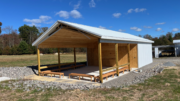You can grow figs in Pennsylvania if you take steps to protect them from the harshest winter temperatures.
There’s nothing like a fresh fig! Despite our northern climate zone and these sub-tropical fig trees (Ficus carica) need for winter protection, we optimistic gardeners are determined to grow figs for their luscious fruit. But edible figs, even the most cold-resistant varieties, only tolerate temps down to 20°F, and will suffer true winter damage below 15°F (except ‘Chicago Hardy’). So what methods will help you to winterize both containerized and already established in-ground figs?
Take a deep breath. Don’t worry if your tree dies back to the base. The main, most productive, and most flavorful crop grows on the current year’s new growth and is harvested in late summer to early fall. Many figs adaptable to colder climates do not usually produce an early breba crop, which grows on the wood of previous years. Fig trees will recover and produce many branches from the roots in a preferred shrub-like, basally-branched configuration, rather than a single trunk form.
Containered Figs: Bring Indoors
If you have containerized fig trees you have more options for protection, provided your container is able to be moved indoors.
- After hard frost remove all remaining leaves and unripe figs.
- Place containers in an insulated unheated preferably dark room, garage, or cool basement. If the space is not dark, you can cover the figs. If you’re lucky enough to have an environmentally controlled greenhouse, you may not need to cover them.
- Water them monthly until just moist so the roots do not dry out completely. Do not overwater.
- Figs require a minimum of 100 hours of chilling in order to produce fruit. So you do not want to keep them toasty. You want them to remain dormant until spring.
- Bring outdoors in April.
- Unless your container fig is very large, do not prune or fertilize until spring.
My containered figs were in a very cold, uninsulated garage so I put straw bales around the pots for added insulation. I have one Mission Fig that is in a 3 by 3-foot pot that I do not move, but protect as if it were in-ground.
In-Ground Figs: Two Protection Methods
Before planting a fig tree in-ground, think about planting in the most protected areas of your yard to insulate your fig from extreme cold and drying winds, such as next to a southern facing wall.
1. Prepare, Wrap and Cover
- As with figs in containers, after a hard frost remove all remaining leaves and unripe figs.
- Protect the base of the plant by mulching 6”-12” with leaves, straw, or other organic materials.
- Prune back the branches to a manageable height. This will encourage new growth in the spring.
- Tie or bungee the branches. They are very flexible and bendable.
- Cover them with burlap, canvas, row cover, a quilt, or other available breathable wrappings (not plastic) to protect them from the wind.
- Encase the whole tree in cardboard.
- Fill loosely with straw or other dry, undiseased materials to leave air space.
- Then tarp to keep moisture out, leaving room at the bottom for air to circulate.
- You could also put an upturned bucket or planting pot on top of wrapping materials.
Cautionary Tales: In the past, I have used bubble wrap or even pipe insulation.
Both of these created moist environments and led to fungal diseases such as powdery mildew. I imagine that any kind of wrapping (like plastic) that does not allow air circulation or water evaporation would encourage diseases. Straw (not hay) used as insulating fill is generally sterile as well as providing air pockets. I have also used leaves as fill around the branches, but many leaves have pre-existing bacterial or fungal issues that could and have affected the branches. One year I had a fig rust infestation that dropped almost half of my leaves in mid-August, so your choice of insulating materials may be one key to success.
2. Trench or Bury
Italian immigrants who brought their fig trees to the United States developed the practice of trenching or burying their fig trees to protect them. First, you must consider your spatial requirements for this time-consuming, yet very effective, method of winter protection.
- Prune the branches to a manageable height.
- Bind these flexible branches with twine, rope, or bungees.
- Dig a trench out from the tree to accommodate its length, width and depth and save this soil nearby.
- Cut down a foot deep around the root ball so that the tree can be bent down into the trench while remaining mostly rooted. Yes, you will be cutting or breaking some roots. But if you keep the central, largest roots intact, the tree won’t be significantly harmed.
- Backfill the removed soil into the trench.
- Put plywood, cardboard, or several thicknesses of paper on top before mulching to keep out mice, voles, or other critters that could damage the branches.
- Finally mulch heavily with soil, straw, and/or other organic material to a depth of one foot.
Resources
“How to Wrap a Fig Tree to Protect It for the Winter” – Brooklyn Botanic Garden
Home Grounds Fact Sheet Cornell Cooperative Extension, “Fig Culture in Northern Climates.”
Grow Figs in Cold Climates
Rutgers New Jersey Agricultural Experiment Station, “Figs in the Home Garden” Fact Sheet FS 1198
This educational blog is a series of informative articles from the Penn State Master Gardeners volunteers plus news concerning the group and their activities. For more information, click here.




































